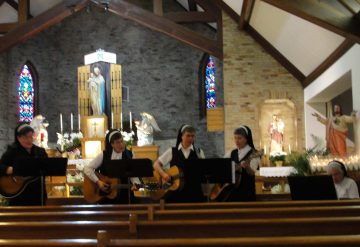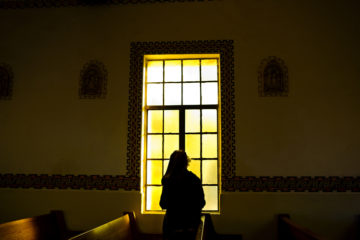Franciscan Sister Kathleen Murphy reflects on Pope Francis’ May Prayer Intention that invites young people to look to Mary for wisdom on important topics.
Perhaps you are wondering how it can be the month of May already. Yet here we are turning our calendars to the new month, the month of Mary and of all mothers. Tradition tells us that Mary was quite young when the Angel Gabriel announced God’s plan for salvation to her and outlined her role in it. Perhaps this is why Pope Francis combines the needs of youth with the example of Mary in this month’s intention. The Holy Father has packed lots of needs into our May intercession. It is: We pray for all young people, called to live life to the fullest; may they see in Mary’s life the way to listen, the depth of discernment, the courage that faith generates, and the dedication to service.
Though there is much to consider here, I will limit my thoughts to considering Mary’s example for young people today. I am referencing an article by Leonard DeLorenzo found in America magazine entitled “Four Lessons from Mary for the Synod on Young Adults”.
Mr. DeLorenzo begins by stating, “The Catholic Church does not have a youth crisis. It has an adult crisis. We have lost touch with what mature discipleship looks like. Because we have, at best, a vague hope for what our children will become, our ways of forming them in the faith are dysfunctional.” Perhaps we have experienced this sense of being “lost” in our work with youth and with families. We may have a clear vision of Church and catechesis, but until families and catechists are equally clear in this vision, our youth will continue to wander around the Church and its teachings without purpose.
Aiming at common content and method in forming young people we look to Mary of Nazareth who embodies what it means to be a disciple.
DeLorenzo states, “There are four marks of Marian discipleship, and these marks recommend pastoral priorities in light of the cultural conditions in which our young people are being raised.” His four marks are silence, memory, mercy, and sacrifice.
We join the author in considering silence. Pope Francis includes discernment in the intention and how can one rightly discern without silence? DeLorenzo says, “The first pastoral priority for forming mature disciples, therefore, aims at Mary’s silence. How do we encourage listening? The task is to create conditions and environments where young people can develop the capacity for attentiveness.” We know that the reality of so many today is filled with the noise and busyness of technology in a digital world. Silence is frequently a rare if unknown quality in the lives of our youth. May they be formed in silence.
Next, the author takes up the mark of memory in the example of Mary as disciple. Mary is listening, but what does she hear? In reflecting on Gabriel’s message to Mary the author writes, “So when Mary learns that Elizabeth—who is old and barren—has conceived a child, she hears “Sarah.” How does she hear that? Through a memory alive with Scripture. Whose voice does she hear? She hears God’s voice—the one who was working then has announced that he is working now in her midst, and her own call is from him.” Catechesis and formation today need to employ Scripture as a steady source of nourishment, not just an infrequent spiritual “snack”. This regular diet of the Word establishes the sense of memory that marks the true disciple. May our youth be formed in a sense of holy memory.
 DeLorenzo turns next to the quality of mercy found in the discipleship of Mary. In receiving God’s word, she acts according to the true measure of divine power: mercy. The article states, “The power of divine mercy reveals itself as the willingness to suffer the consequences of a power-hungry world rather than play its game.” So, the way to teach mercy is to practice the works of mercy, not sporadically but regularly. Practicing mercy both in the home and outside of it, is key to forming young people to see the world within the possibilities of mercy. May the young be formed so as to walk the path of mercy.
DeLorenzo turns next to the quality of mercy found in the discipleship of Mary. In receiving God’s word, she acts according to the true measure of divine power: mercy. The article states, “The power of divine mercy reveals itself as the willingness to suffer the consequences of a power-hungry world rather than play its game.” So, the way to teach mercy is to practice the works of mercy, not sporadically but regularly. Practicing mercy both in the home and outside of it, is key to forming young people to see the world within the possibilities of mercy. May the young be formed so as to walk the path of mercy.
Finally, we turn to the quality of sacrifice seen in Mary and sought out in every true disciple. Once Mary hears well, she acts. We are told that she went “with haste” to help Elizabeth. She is ready to respond to the word of God. She is free. When she said, “Let it be to me according to your word,” she was true to that yes, all the way to the end. We are to challenge young people to “be someone who responds to God’s call and to accept the sacrifices entailed in living out that commitment. We live today in a culture of indecision, where the plethora of possibilities paralyzes us. But the heart of vocational discernment is declaring a definitive yes with your life to a particular path.”
Mary certainly saw the singular path to which she was called. She did not try to turn back when she faced suffering. Today’s youth seem hesitant to close the door on any feasible choice. They want to keep all options open for as long as possible. DeLorenzo concludes, “Forming our young people through fidelity to fewer but stronger commitments over the long run will prepare them better for the more meaningful and sacrificial commitments that are the purchase price of the “joy of love.” May the young be formed in the way of sacrifice.
As we join Pope Francis in prayer for youth this month, we pray that they become what Mary is: people who hear the word of God and act on it. We pray that we are open to our role in forming such youth for the future. As DeLorenzo concludes, “The sweet duty of the church is to form young people to be generators of culture—cultures of holiness and joyful love—that will feed the generation after them. The church must prepare them to make that sacrifice.” Let us pray that we will contribute to forming young people in the pattern of Mary who was formed in silence, memory, mercy and sacrifice.



